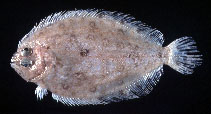| Family: |
Paralichthyidae (Large-tooth flounders) |
| Max. size: |
37.5 cm TL (male/unsexed); max.weight: 760.0 g |
| Environment: |
demersal; marine; depth range 7 - 200 m |
| Distribution: |
Indian Ocean: throughout the region including the Red Sea and Persian Gulf; south to Algoa Bay in South Africa (Ref. 4417). Western Pacific: Taiwan southward to New Guinea and extending to the northeastern coast of Australia. |
| Diagnosis: |
Dorsal spines (total): 0-0; Dorsal soft rays (total): 67-74; Anal spines: 0-0; Anal soft rays: 52-66. Eyed side with dark rings arranged in about 5 longitudinal rows; dark blotch at junction of straight and curved parts of lateral line and 2 smaller ones on the lateral line at posterior part of body and anterior end of caudal peduncle; small dark spots and elongate markings on median fins; pectoral fins with 10-12 rays on eyed side, 10-11 rays on blind side (Ref. 4417). |
| Biology: |
Found on clay, sand and mud bottoms of the continental shelf. Feeds on benthic animals (Ref. 5213). Mainly sold fresh. |
| IUCN Red List Status: |
Least Concern (LC); Date assessed: 10 March 2021 Ref. (130435)
|
| Threat to humans: |
harmless |
Source and more info: www.fishbase.org. For personal, classroom, and other internal use only. Not for publication.

